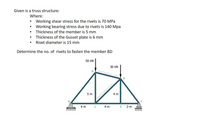
Structural Analysis
6th Edition
ISBN: 9781337630931
Author: KASSIMALI, Aslam.
Publisher: Cengage,
expand_more
expand_more
format_list_bulleted
Question
Complete solution with free body diagram

Transcribed Image Text:Given is a truss structure:
Where:
• Working shear stress for the rivets is 70 MPa
• Working bearing stress due to rivets is 140 Mpa
• Thickness of the member is 5 mm
• Thickness of the Gusset plate is 6 mm
• Rivet diameter is 15 mm
Determine the no. of rivets to fasten the member BD
50 kN
30 kN
5m
4 m
4 m c 4m E 3 m
Expert Solution
This question has been solved!
Explore an expertly crafted, step-by-step solution for a thorough understanding of key concepts.
This is a popular solution
Trending nowThis is a popular solution!
Step by stepSolved in 3 steps with 2 images

Knowledge Booster
Learn more about
Need a deep-dive on the concept behind this application? Look no further. Learn more about this topic, civil-engineering and related others by exploring similar questions and additional content below.Similar questions
- Civil engineering Finite Elements questions Consider the 2-noded element shown in Fig. 1 that has nodes at x = −1 andx = +1.(a) Write the shape functions N1(x) and N2(x).(b) Show that the shape functions satisfy the Kronecker delta property, i.e., Ni(x) = 1 atnode i and zero at the other node(s).(c) Show that the shape functions satisfy the ”Rigid Body mode(s)” condition, i.e., N1(x)+N2(x) = 1.(d) Show that the shape functions satisfy the ”Constant Strain state(s)” condition, i.e.,N1(x)x1 + N2(x)x2 = x.arrow_forwardNOTE: 1. The following are grounds for not considering your solution and final answers: a)Figures not properly labeled. b)Equations that are not consistent with the firgure. C)Equilibrium equations do not have sign conventions. d) unsequenced solution. e) answers without units 2. Computations accurate to the nearest tenths. Problem. Show that the following structures are statically determinate and determine the support reactions. c) hinge at C 30 k 60 k 30 k 60 k 10 ft 15 ft 20 ft B 6 at 15 ft 90 ftarrow_forwardPart C - Counterclockwise Rotation of a Stress Element Figure 5 of 6 The state of stress at a point in a member is shown on the rectangular stress element in (Figure 5) where the magnitudes of the stresses are |0z| = 13 ksi, Joy = 23 ksi, and |Tzy| = 12 ksi. Determine the state of stress on an element rotated 45° counterclockwise from the element shown. Express your answers, separated by commas, to three significant figures. • View Available Hint(s) Vol AEO I vec Or =, oy =, Tự'y = ksi, ksi, ksi Submit Pearsonarrow_forward
- NOTE: 1. The following are grounds for not considering your solution and final answers: a)Figures not properly labeled. b)Equations that are not consistent with the firgure. C)Equilibrium equations do not have sign conventions. d) unsequenced solution. e) answers without units 2. Computations accurate to the nearest tenths. Problem. Show that the following structures are statically determinate and determine the support reactions. b) B is pin connected, C is fixed, hinge supports A and D. 8 kN 8 kN 2 m -2 m 3 kN/m C 4 m D -3 marrow_forwardplease help, thanksarrow_forwardA differential element on the bracket is subjected to plane strain that has the following components: , strain at x = 250 x 10-6, strain at y = 300 x 10-6, strain at x y= -500 x 10-6. Use the strain-transformation equations and determine the normal strain strain x' in the x' direction on an element oriented at an angle of 35°. Note, a positive angle is counter clockwise.arrow_forward
- Write the number of elements, nodes required and degree of freedom to solve following truss using FEM (Use the best node/element numbering; Do not need to solve it!) Would ANSYS be able to solve the structure with given Boundary Conditions (BC)? If not, what should be done and why?arrow_forwardWhy should an element subjected to maximum shear stress be oriented?arrow_forwardFor fluid undergoing circular motion, the centripetal force is provided by a pressure difference. Consider a fluid element (density p) at radial distance r, which has thickness dr in the radial direction and surface area dA normal to the radial direction. The pressure difference gives rise to a force on the fluid element equal to (p(r + dr) – p(r))dA. (i) Equating the pressure difference to the centripetal force, find an expression for the radial pressure gradient in terms of p, r, and fluid velocity v. (ii) A fluid is undergoing body rotation in the r-0 plane (cylindrical polar co-ordinates). By considering the gravitational pressure head, show that the shape of a free surface z(r) is parabolic. (iii) Find and sketch a similar expression for the free surface of a fluid vortex produced by a rotating cylindrical spindle (i.e. a solid cylindrical rod) of radius Ro.arrow_forward
arrow_back_ios
arrow_forward_ios
Recommended textbooks for you

 Structural Analysis (10th Edition)Civil EngineeringISBN:9780134610672Author:Russell C. HibbelerPublisher:PEARSON
Structural Analysis (10th Edition)Civil EngineeringISBN:9780134610672Author:Russell C. HibbelerPublisher:PEARSON Principles of Foundation Engineering (MindTap Cou...Civil EngineeringISBN:9781337705028Author:Braja M. Das, Nagaratnam SivakuganPublisher:Cengage Learning
Principles of Foundation Engineering (MindTap Cou...Civil EngineeringISBN:9781337705028Author:Braja M. Das, Nagaratnam SivakuganPublisher:Cengage Learning Fundamentals of Structural AnalysisCivil EngineeringISBN:9780073398006Author:Kenneth M. Leet Emeritus, Chia-Ming Uang, Joel LanningPublisher:McGraw-Hill Education
Fundamentals of Structural AnalysisCivil EngineeringISBN:9780073398006Author:Kenneth M. Leet Emeritus, Chia-Ming Uang, Joel LanningPublisher:McGraw-Hill Education
 Traffic and Highway EngineeringCivil EngineeringISBN:9781305156241Author:Garber, Nicholas J.Publisher:Cengage Learning
Traffic and Highway EngineeringCivil EngineeringISBN:9781305156241Author:Garber, Nicholas J.Publisher:Cengage Learning


Structural Analysis (10th Edition)
Civil Engineering
ISBN:9780134610672
Author:Russell C. Hibbeler
Publisher:PEARSON

Principles of Foundation Engineering (MindTap Cou...
Civil Engineering
ISBN:9781337705028
Author:Braja M. Das, Nagaratnam Sivakugan
Publisher:Cengage Learning

Fundamentals of Structural Analysis
Civil Engineering
ISBN:9780073398006
Author:Kenneth M. Leet Emeritus, Chia-Ming Uang, Joel Lanning
Publisher:McGraw-Hill Education


Traffic and Highway Engineering
Civil Engineering
ISBN:9781305156241
Author:Garber, Nicholas J.
Publisher:Cengage Learning